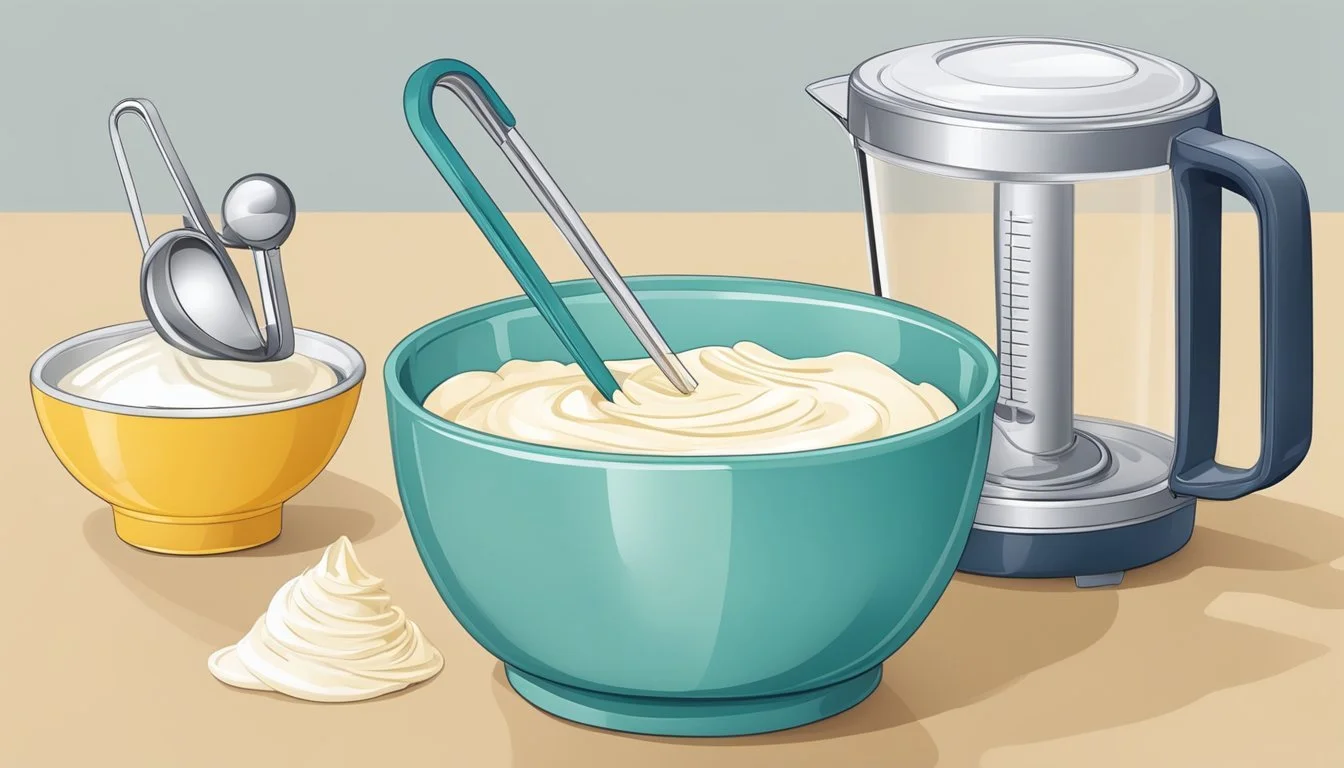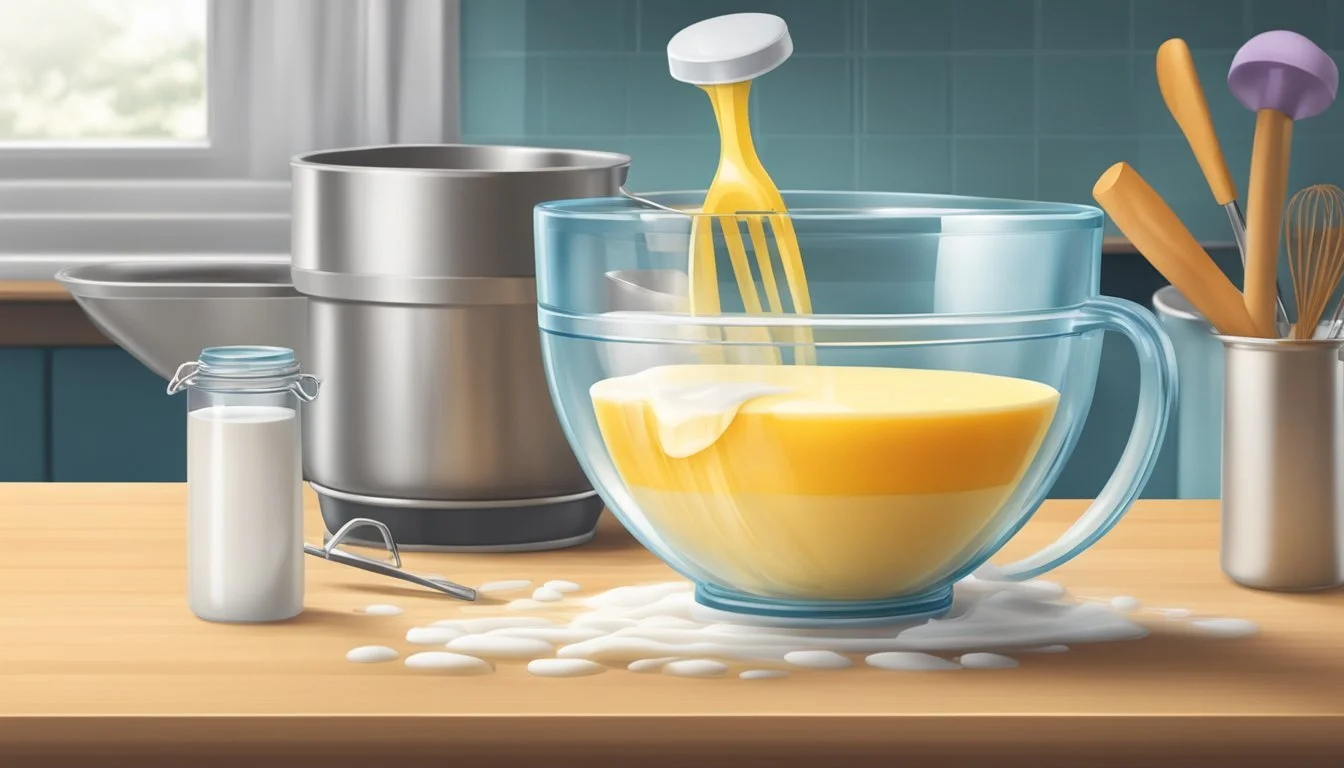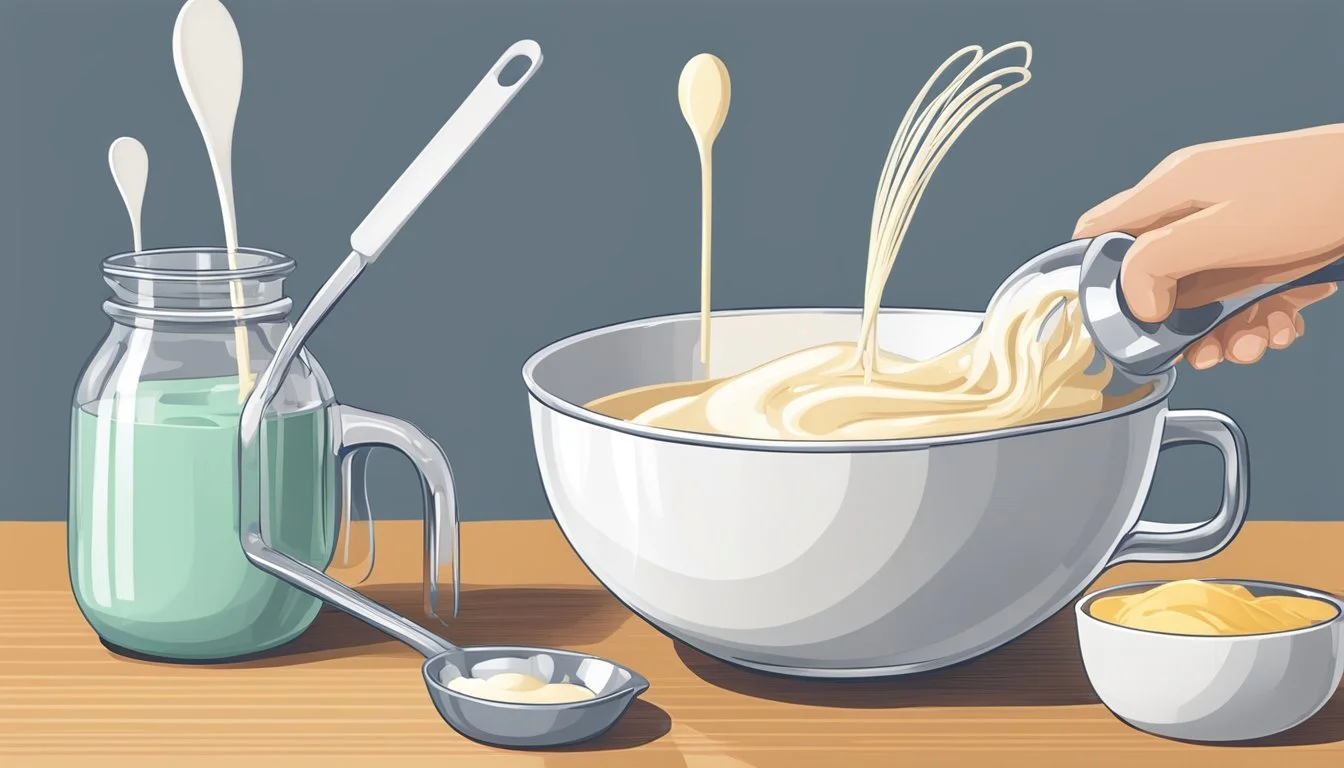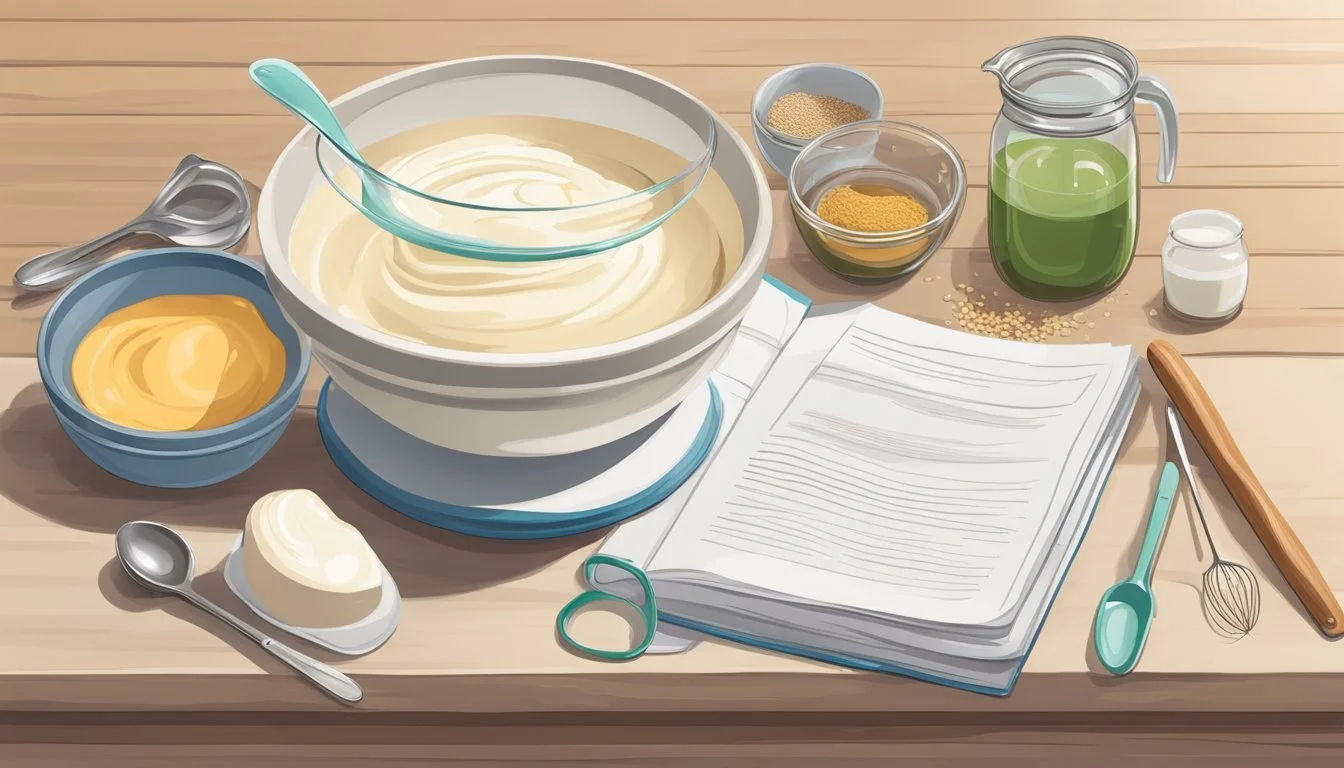How to Measure the Perfect Amount of Cream for Whipping
A Precise Guide
Whipping cream is a fundamental skill for both novice and seasoned bakers, providing a light, airy touch to a variety of desserts (What wine goes well with desserts?). The key to achieving the perfect consistency lies not only in the technique but also in measuring the correct amount of cream. Accurate measurements ensure that the cream whips to its full potential, offering the desired texture for toppings, fillings, and other sweet creations.
The process begins with chilled heavy cream, as temperature plays a crucial role in the cream's ability to hold air and volume when whipped. Chefs typically use a measuring cup to quantify the desired quantity of cream, adhering to the principle that 1 cup of liquid whipping cream yields nearly double its volume when whipped. For smaller quantities, a tablespoon can suffice, particularly when a recipe calls for a dollop rather than copious amounts.
Precision in measurement and preparation enables one to make homemade whipped cream successfully. By maintaining a chilled environment and employing accurate tools, one can ensure that the cream not only reaches but retains the necessary peaks, transforming the liquid ingredient into a sumptuous and stable whipped topping perfect for enhancing the flavors and presentation of various dishes.
Understanding Whipping Cream
Identifying the right type of cream and understanding its fat content are essential steps towards achieving the perfect whipped cream.
Identifying the Right Cream
Selecting the appropriate cream is crucial for successful whipping. Heavy whipping cream and whipping cream differ slightly in fat content, with heavy whipping cream containing more fat. For whipping purposes, one should use a product labeled either as "whipping cream" or "heavy whipping cream," as both are capable of being whipped into a light, airy structure when enough air is incorporated.
Fat Content and Its Importance
The fat content in cream determines how well it will whip and hold its shape. Whipping cream generally has a fat content of around 30%, while heavy whipping cream contains about 36% to 38% fat. This higher fat content is important because it provides stability to the final product, allowing the whipped cream to maintain its form and texture. When whipped, the fat within the cream stabilizes the air bubbles that are introduced during the whipping process, which is critical for achieving the desired consistency.
Preparation Basics
Before one begins the process of whipping cream, two crucial steps must be taken to ensure success: chilling the ingredients and selecting the appropriate equipment for mixing.
Chilling the Ingredients
To achieve the best results when whipping cream, one must start with cold ingredients. Heavy cream should be refrigerated until the moment it is needed. Chilling is key; it increases the cream's volume and helps it whip more quickly. For optimal results, utensils can also be chilled. Placing the bowl and whisk (or whisk attachment if using a stand mixer) in the fridge for at least 15 minutes before use will maintain the cream's temperature during whipping.
Selecting the Proper Bowl and Whisk
The choice of bowl greatly affects the whipping process. A bowl with a smaller base and higher sides is preferable because it allows for efficient beating without spilling. Materials like stainless steel or glass, chilled beforehand, enhance the process.
The whisk or mixer one uses should be suitable for the amount of cream being whipped. A hand mixer or stand mixer with a whisk attachment can significantly reduce the time and effort required. For smaller batches or without electrical appliances, a balloon whisk is recommended, though it will require more physical effort.
Equipment Purpose Bowl A container to hold the cream, preferentially with a small base and tall sides, that can be chilled. Whisk A tool to incorporate air into the cream, options include a balloon whisk for hand whisking, or a whisk attachment for mixers. Fridge To chill cream and equipment for optimal whipping. Hand Mixer An electric device that provides a medium between manual whisking and a stand mixer. Ideal for small to medium batches. Stand Mixer For larger batches of cream or a more hands-off approach, utilizes a whisk attachment.
By keeping these preparation basics in mind, one can ensure that their cream will be whipped to the perfect consistency for their culinary needs.
Whipping Techniques
In the process of whipping cream, the techniques used can significantly affect the texture and volume. Different tools and methods lead to varying consistencies, from soft and billowy to firm and stable peaks.
Manual Whisking vs. Electric Mixer
Manual whisking requires a balloon whisk and some endurance. The whisker moves the whisk back and forth, introducing air into the cream, which can take several minutes. It provides more control but is labor-intensive. In contrast, an electric mixer, either handheld or stand, makes the process much faster and less physically demanding. Users should start at a low speed to prevent splattering, then gradually increase to medium-high speed as the cream begins to thicken to achieve the desired peaks.
Achieving the Desired Peaks
Whipped cream can be beaten to three main types of peaks: soft, medium, and stiff peaks. Soft peaks gently bend over at the tips when the whisk is lifted. Medium peaks stand straight with a slight curl at the tip, suitable for topping desserts. Stiff peaks, ideal for piping, hold their shape firmly without any drooping. It's important to stop whipping as soon as the desired peak consistency is reached to avoid overbeating, which can lead to a clumpy, butter-like texture.
Adjusting Whipping Speeds
The whipping speed is critical in the cream's transformation. Start at a low speed to incorporate air without spraying cream everywhere. As it thickens, increase to a medium-high speed to build volume efficiently. For soft peaks, a slower speed towards the end can prevent overbeating. Conversely, reaching stiff peaks may require sustaining a higher speed longer. Continuously check the peak stage to avoid over-whipping. An electric mixer can greatly reduce the time and effort needed to achieve the desired peaks, especially for larger volumes.
Flavoring and Sweetening
When preparing whipped cream, the right balance of sweetness and flavor is crucial to enhance its taste. How one chooses to sweeten and flavor their whipped cream can vary greatly based on personal preference and the dessert it accompanies.
Incorporating Sugar and Sweeteners
To sweeten whipped cream, granulated sugar is commonly used for its ability to dissolve easily when whipped with cream. For a smoother consistency, powdered sugar, also known as confectioners' sugar, is preferred as it incorporates smoothly without leaving any grittiness. Depending on the desired sweetness, start with one to two tablespoons of sugar per cup of heavy cream.
For those looking for natural alternatives, liquid sweeteners like maple syrup or honey should be added gradually, as they can affect the cream's ability to hold its form if overused. The proportion of sweetener to cream will depend on its type and the level of sweetness desired by the individual. Start with one tablespoon per cup and adjust to taste.
Adding Flavor Extracts and Spices
To infuse homemade whipped cream with flavor, begin by adding pure vanilla extract—about 1/2 teaspoon per cup of cream offers a subtle, aromatic lift creating a classic vanilla whipped cream. A small amount of cocoa powder can transform it into a rich, chocolatey topping.
For more unique varieties, incorporate ground spices such as cinnamon for a warm, spiced whipped cream, or even bourbon for a boozy twist. Always add these flavorings in small increments to avoid overpowering the cream—generally 1/4 to 1/2 teaspoon of spices or one to two tablespoons of liquor per cup of heavy cream should suffice.
Experiment with different spices and flavorings to find the combination that best complements your dessert, adjusting quantities carefully to refine the taste to your liking.
Quantities and Measurements
Understanding the correct quantities and measurements for whipping cream is crucial to achieving the desired consistency and volume for culinary applications.
Determining Cream Volume
When working with heavy cream for whipping, it's essential to start with accurate volumetric measurements. Typically, one measures heavy cream in milliliters (ml) or cups depending on the quantity required.
1 cup of unwhipped heavy cream is approximately 238 ml.
For smaller amounts, utilizing a tablespoon is practical, with 1 tablespoon being approximately 14.8 ml.
Volume Conversion Table:
Cups Milliliters Tablespoons 1 238 16 3/4 178.5 12 1/2 119 8 1/4 59.5 4
Scaling Ingredients for Recipes
A recipe might specify the amount of whipped cream in volume or as a serving size. Properly scaling heavy cream volumes ensures that each serving contains the right proportion of whipped cream.
To scale ingredients, one must calculate the volume of cream based on the serving size required by the recipe.
If a recipe calls for a specific number of servings, multiply the single serving volume by the number of servings to find the total volume of cream needed to whip.
For instance, if a recipe requires 1/2 cup of whipped cream per serving and serves 4:
1/2 cup x 4 servings = 2 cups of heavy cream required for whipping.
Advanced Tips and Techniques
In the pursuit of achieving the perfect whipped cream, chefs and home bakers alike should embrace some refined strategies. Specific techniques can stabilize whipped cream for extended utility, and there are trusted methods to correct over-whipping, which is a common mishap.
Stabilizing Whipped Cream for Longer Use
For whipped cream that maintains its texture and form over time, one can employ stabilizing agents. Cornstarch and confectioners' sugar are two such agents that can be used effectively. The addition of a small ratio of cornstarch (about 1 teaspoon for every cup of heavy cream) or confectioners' sugar, which contains cornstarch, can help to form a stabilized whipped cream that holds stiff peaks longer. This approach is particularly useful when the whipped cream needs to be used as frosting or when it must withstand room temperature for a while.
Fixing Common Issues with Over-whipped Cream
Turning over-whipped cream, which often takes on a curd-like texture, back into the smooth and airy topping one desires, is a delicate process. To salvage over-whipped cream, one should immediately stop whipping and gently fold in additional heavy cream, a tablespoon at a time, using a whisk or spatula. This can help to incorporate more liquid and smooth out the mixture. It's important to recognize the threshold between stiff peaks and over-whipped textures to avoid reaching the point where the cream turns into butter.
Integration With Desserts
Whipped cream's volume and consistency are crucial when pairing it with desserts. Proper measurement ensures that the desired texture complements the dessert without overpowering it.
Pairing with Cakes and Pies
When serving cakes and pies, the whipped cream should not only complement the main dessert in flavor but also in proportion. For instance:
Pumpkin Pie: Generally, a dollop of about two tablespoons of whipped cream per serving suffices, allowing the spiced flavor of the pie to remain prominent.
French Silk Pie: This pie demands a more generous amount of whipped cream; typically a 1:1 ratio with each pie slice to balance the dense chocolate.
Pecan Pie: It pairs well with a lighter serving of whipped cream, about one tablespoon, to add a creamy texture without overshadowing the nutty and sticky filling.
Measurements for Cakes:
Cake Type Whipped Cream Serving Size Layered sponge cake 1/3 cup per layer Cream puffs 1-2 tablespoons per puff Sweet potato pie 2 tablespoons per serving
Experts recommend whipping cream just before serving to maintain its structure and provide the freshest flavor.
Frosting and Toppings for Sweets
Frosting requires whipped cream to be more firm to hold shapes and designs. It often involves:
Stabilizers like confectioner's sugar or gelatin to prevent the cream from deflating.
Gradually adding sweetener during whipping; start with 1/4 cup and adjust to taste.
For toppings, a flawless integration is achieved by considering the dessert's texture:
A frothy and light whipped cream is a delightful contrast to dense sweets such as brownies.
A slightly heavier and richer cream works well with delicate pastries, where it can be used as a filling without causing sogginess.
In all instances, maintaining the cream's chill until served preserves its texture and compliments the dessert's structure.
Innovative Uses and Variations
Whipped cream can be customized in various ways to enhance flavor profiles and accommodate dietary restrictions. Innovative twists using infusions and exploring dairy alternatives broaden whipped cream's versatility.
Infusing Liquors and Extracts
Homemade whipped cream gains complexity with the infusion of liquors and extracts. Here’s how to incorporate them:
Maple Bourbon Whipped Cream: Add 1-2 tablespoons of bourbon and 1 tablespoon of maple syrup during whipping.
Mint Whipped Cream: Include a few drops of mint extract for a fresh, vibrant flavor.
Rum Whipped Cream: Mix in 1 tablespoon of rum for a subtle, boozy note.
Vanilla Extract: For a classic taste, use 1 teaspoon of pure vanilla extract, which brings a warm, rich flavor.
Exploring Dairy-Free Alternatives
For those seeking non-dairy options, the market offers several alternatives:
Coconut Cream: For a tropical twist, chill a can of full-fat coconut milk and whip the solidified cream.
Dairy-Free Milks: Combine dairy-free milk with stabilizers like cornstarch to mimic the consistency of whipped cream.
By adapting these innovations, chefs can cater to diverse palates while maintaining the allure of whipped cream.
Storage and Safety
Storing whipped cream correctly is essential to maintain its texture and prevent spoilage. Refrigeration at the right temperature helps avoid weeping and separation, ensuring the whipped cream remains stable for use.
Proper Refrigeration Practices
Whipped cream should be stored in the fridge, ideally at a temperature between 34°F and 38°F (1°C and 3°C). The container needs to be airtight to ensure no external odors are absorbed and the cream remains fresh. One should place the container towards the back of the fridge, where the temperature is most constant, rather than in the door where temperature fluctuations are more common.
Checklist for Refrigeration:
Seal in an airtight container
Position in the back of the fridge
Maintain steady temperature within 34°F to 38°F
Preventing Weeping and Separation
To prevent whipped cream from weeping (losing water) and separating, one should ensure it is not exposed to warm temperatures for lengthy periods. Additionally, stabilizers such as confectioners' sugar or cornstarch can be added during whipping to enhance the cream's stability. If the whipped cream does begin to separate, it can often be re-whisked gently to reincorporate the liquid and air.
Tips to Avoid Weeping:
Avoid prolonged exposure to warm environments
Include stabilizers like confectioners' sugar
Re-whisk gently if separation occurs
Serving Suggestions
In considering the perfect amount of whipped cream for various uses, one must think about both the type of dessert as well as the desired presentation. A well-measured serving enhances both flavor and visual appeal.
Accompaniments and Pairings
To perfectly complement a dessert, it is critical to match the whipped cream's volume to the dessert's size and richness. For instance:
Fruit: A generous dollop, about 2 tablespoons, pairs well with a bowl of mixed berries.
Cakes and Pancakes: Approximately 1/4 cup of whipped cream is suitable for a single serving slice of cake or a stack of pancakes.
Hot Chocolate and Coffee: A swirl of whipped cream, roughly 2 tablespoons, adds a luxurious touch to these hot beverages.
One must always consider the balance between the whipped cream and the main dish, ensuring neither overpowers the other.
Garnishing and Presentation
The presentation of whipped cream can transform a simple dessert into an elegant treat:
Desserts: A quenelle or a piped star of whipped cream adds sophistication.
Cakes: For a cake, artful dollops around the edges garnish each slice.
Pancakes: A light layer of whipped cream between pancakes layers provides added decadence.
Hot Chocolate/Coffee: A swirl on top acts as an invitation to indulge.
Always serve whipped cream chilled and apply it just before serving to maintain texture and form.
Whipped Cream in Popular Culture
Whipped cream, a staple in desserts, has solidified its status within culinary media and festive cooking traditions, often showcased in articles and cooking guides as a versatile and beloved ingredient by chefs and home cooks alike.
Presence in Culinary Media
Culinary media often features whipped cream due to its visual appeal and versatility. Chefs on cooking shows and writers of cooking blogs frequently demonstrate techniques for making perfect whipped cream, emphasizing its role in enhancing the texture and flavor of desserts. Guides on whipped cream preparation are a common article type in culinary magazines, highlighting tips and tricks for achieving the perfect consistency, whether for dolloping onto pies or creating intricate dessert toppings.
Television: Chefs on cooking segments use whipped cream to finish dishes with a flourish, emphasizing technique.
Print and Online Articles: Extensive guides explore the science and art of making whipped cream.
Social Media: Food influencers share photos and videos of homemade whipped cream, inspiring followers to try their own.
Impact on Holiday and Festive Cooking
The use of whipped cream peaks during the holiday and festive seasons. It is an essential component in many holiday desserts, from pumpkin pie at Thanksgiving to festive Christmas yule logs. Chefs and home cooks alike prioritize the use of homemade whipped cream to elevate their holiday dishes, underscoring its cultural significance.
Holiday Recipes: Numerous articles and guides feature whipped cream as a key ingredient in holiday desserts.
Homemade Appeal: Homemade whipped cream is often preferred over store-bought for its fresher taste and lack of additives.
Cultural Traditions: Many cultures incorporate whipped cream into their festive cooking, underscoring its global appeal.
By understanding the prominent role of whipped cream in popular culture, one can appreciate its significance beyond a mere dessert topping, as it embodies tradition, artistry, and culinary expression.
Conclusion
Measuring the right amount of cream for whipping is a key step in achieving the desired consistency for various culinary applications. To ensure success, cooks should start with cold cream and tools, as this facilitates quicker whipping and better structure. The amount of cream to use will depend on its final purpose; desserts might require a lighter consistency, while frosting or fillings might need firmer peaks.
As a rule of thumb, whipped cream will roughly double in volume. Therefore, if a recipe calls for 2 cups of whipped cream, it is safe to start with 1 cup of heavy or whipping cream. Immediate use is recommended for optimal texture, although whipped cream can be stored in the refrigerator. To maintain its structure, it's advised to place it on a fine-mesh strainer over a bowl and cover with plastic wrap to allow for air circulation and excess liquid to drain, preventing it from becoming watery.
For small batches, a balloon whisk is an excellent tool to incorporate air efficiently. Larger quantities may require an electric mixer for convenience and consistency. In any case, vigilance is necessary to prevent overbeating, which can result in a grainy texture.
Ultimately, accurate measuring, attention to temperature, and proper technique will guide any individual in making perfect whipped cream. With these tips, one can confidently approach various desserts, complementing them with the light, velvety texture that only well-prepared whipped cream can provide.












